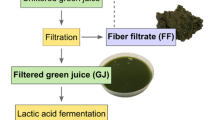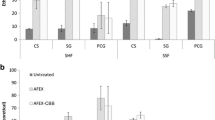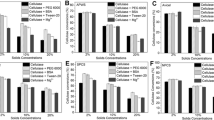Abstract
Front-end protein recovery from biomass at different maturities, and its effects on chemical pretreatment and enzyme hydrolysis of partially deproteinized fiber were investigated. The protein recovery from alfalfa and switchgrass biomass using sodium dodecyl sulfate and potassium hydroxide treatments was ~50–65 % of initial biomass protein. When hot water was used as extraction media, the protein recovery was 52.9 and 43.7 % of total protein in switchgrass and alfalfa, respectively. For any treatment, relative protein recovery was higher from switchgrass than from alfalfa. Only approximately half the total protein was recovered from relatively mature (early fall) biomass compared with midsummer harvested biomass. When protein was recovered partially using sodium dodecyl sulfate or potassium hydroxide, and leftover fiber pretreated, aqueous ammonia pretreatment removed 58.5–60.1 % of lignin and retained more cellulose in the fiber compared with acid pretreatment (nearly no lignin removal). Protein removal was helpful in the enzyme digestibility of fibers. Delignification of ammonia pretreated partially deproteinized alfalfa fiber was in the range of 34.4–45 %, while dilute sulfuric acid did not remove lignin effectively. Overall, the higher delignification and enzyme digestibilities were observed in aqueous ammonia pretreated partially deproteinized alfalfa fibers regardless of biomass type.



Similar content being viewed by others
References
Dale BE, Allen MS, Laser M, Lynd LR (2009) Protein feeds coproduction in biomass conversion to fuels and chemicals. Biofuels Bioproducts Biorefining 3(2):219–230
Walker HG, Kohler GO (1983) Utilization of press cake from LPC operations. In: Telek L, Graham HD (eds) Leaf protein concentrates. AVI Publishing, Connecticut
Bals B, Teachworth L, Dale BE (2007) Extraction of proteins from switchgrass using aqueous ammonia within an integrated biorefinery. Appl Biochem Biotechnol 143:187–198
Bae DH, Gilman BE, Welch JG, Palmer RH (1983) Quality of forage from Miscanthus sinensis. J Dairy Sci 66:630–633
Dale BE, Matsuoka M (1981) Protein recovery from leafy crop residues during biomass refining. Biotechnol Bioeng 23(6):1417–1420
Takara D, Khanal S (2011) Green processing of tropical banagrass into biofuel and biobased products: an innovative biorefinery approach. Biores Technol 102:1587–1592
Lamsal BP, Koegel RG, Boettcher ME (2003) Separation of protein fractions in alfalfa juice: effects of some pretreatment methods. T ASAE 46(3):715–720
Mullen CA, Boateng AA (2008) Chemical composition of bio-oils produced by fast pyrolysis of two energy crops. Energy Fuels 22(3):2104–2109
Tan LL, Li CZ (2000) Formation of NOx and SOx precursors during the pyrolysis of coal and biomass. Part I. Effects of reactor configuration on the determined yields of HCN and NH3 during pyrolysis. Fuel 79(15):1883–1889
NREL (National Renewable Energy Laboratory) (2008) LAP (Laboratory Analytical Procedure). http://www.nrel.gov/biomass/analytical_procedures.html. Golden, CO, USA
ASABE Standards (2008) 55th edn, American Society of Agricultural and Biological Engineers, St. Joseph
AOAC International (1998) Official Methods of Analysis of AOAC International, 16th edn, 4th rev. Method 992.23—Crude Protein in Cereal Grains and Oilseeds—Generic Combustion Method, The Association, Gaithersburg
Wu Z, Lee YY (1997) Ammonia recycled percolation as a complementary pretreatment to the dilute-acid process. Appl Biochem Biotech 63–65:21–34
Taso GT, Ladisch MR, Voloch M, Bienkowski P (1982) Production of ethanol and chemicals from cellulosic materials. Process Biochem 17(5):34–38
Bienkowski P, Ladisch MR, Voloch M, Taso GT (1984) Acid hydrolysis of pretreated lignocelluloses from corn residue. Biotechnol Bioeng Symp Ser 14:512–524
McMillan JD (1994) Pretreatment of lignocellulosic biomass. In: Himmel ME, Baker JO, Overend RP (eds) Enzymatic conversion of biomass for fuels production, ACS Symp Series, vol 566. ACS, Washington, DC
Hsu TA (1996) Pretreatment of biomass. In: Wyman CE (ed) Handbook on bioethanol production and utilization. Taylor & Francis, Washington, DC
Jacobsen SE, Wyman CE (2000) Applied Biochemistry and Biotechnology 84–86(1–9):81–96
Lee YY, Iyer P, Torget RW (1999) Dilute-acid hydrolysis of lignocellulosic biomass. Adv Biochem Eng Biotechnol 65:93–115
Ruttan RF (1909) Ethyl alcohol from sawdust and other wood waste. Soc Chem Ind 28:1290–1294
Faith WL, Hall JA (1944) Ethyl alcohol from waste wood by a modified Scholler process. Chem Eng News 22:525–526
Sherrard EC, Kressman FW (1945) Review of process in the United States prior to World War II. Ind Eng Chem 37(1):5–8
Harris EE, Begliner E, Hajny GJ, Sherrard EC (1945) Hydrolysis of wood. Treatment with sulfuric acid in a stationary digester. Ind Eng Chem 37(1):12–23
Faith WL (1945) Development of the Scholler process in the United States. Ind Eng Chem 37(1):9–11
Harris EE, Begliner E (1946) Madison wood sugar process. Ind Eng Chem 38:890–895
Mosier N, Wyman C, Dale BE, Elander R, Lee YY, Holtzapple M, Ladisch M (2005) Features of promising technologies for pretreatment of lignocellulosic biomass. Biores Technol 96:673–686
Kim TH, Lee YY (2006) Fractionation of corn stover by hot-water and aqueous ammonia treatment. Biores Technol 97:224–232
Kim TH (2011) Sequential hydrolysis of hemicellulose and lignin in lignocellulosic biomass by two-stage percolation process using dilute sulfuric acid and ammonium hydroxide. Korean J Chem Eng 28(11):2156–2162
Acknowledgments
The funding for work was provided by Iowa State University through Agricultural Experiment Station Project. We appreciate Dr. John F. Schmitz’s preliminary work on protein separation from biomass.
Author information
Authors and Affiliations
Corresponding author
Rights and permissions
About this article
Cite this article
Kim, T.H., Yoo, C.G. & Lamsal, B.P. Front-end recovery of protein from lignocellulosic biomass and its effects on chemical pretreatment and enzymatic saccharification. Bioprocess Biosyst Eng 36, 687–694 (2013). https://doi.org/10.1007/s00449-013-0892-8
Received:
Accepted:
Published:
Issue Date:
DOI: https://doi.org/10.1007/s00449-013-0892-8




